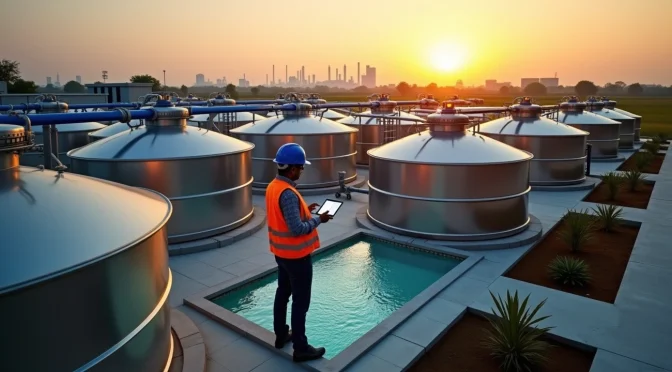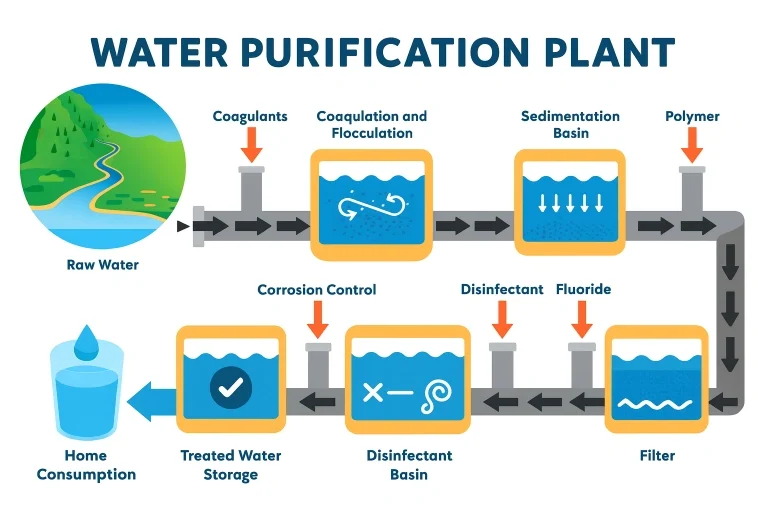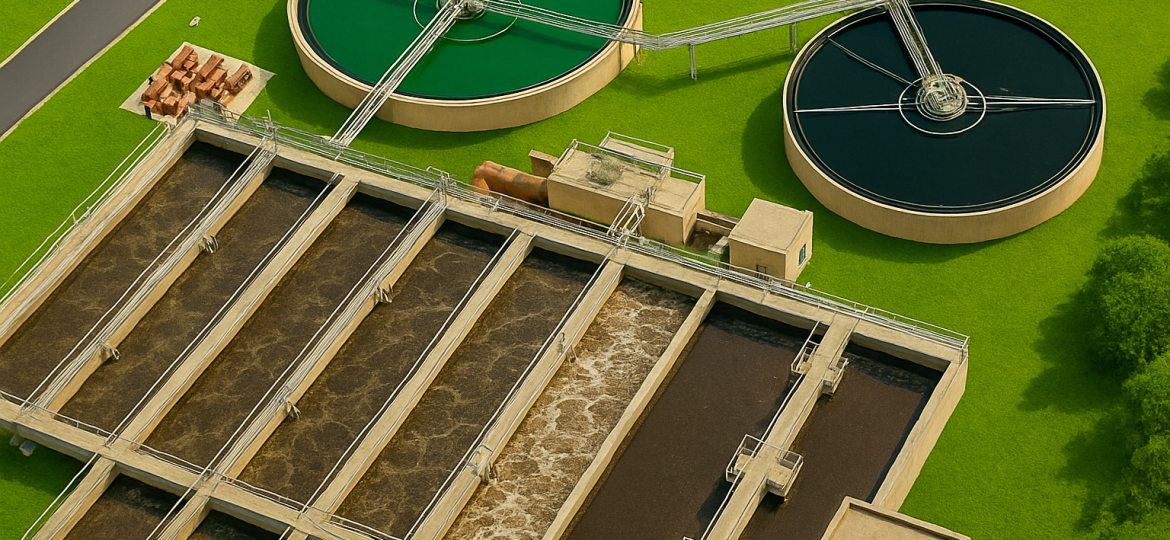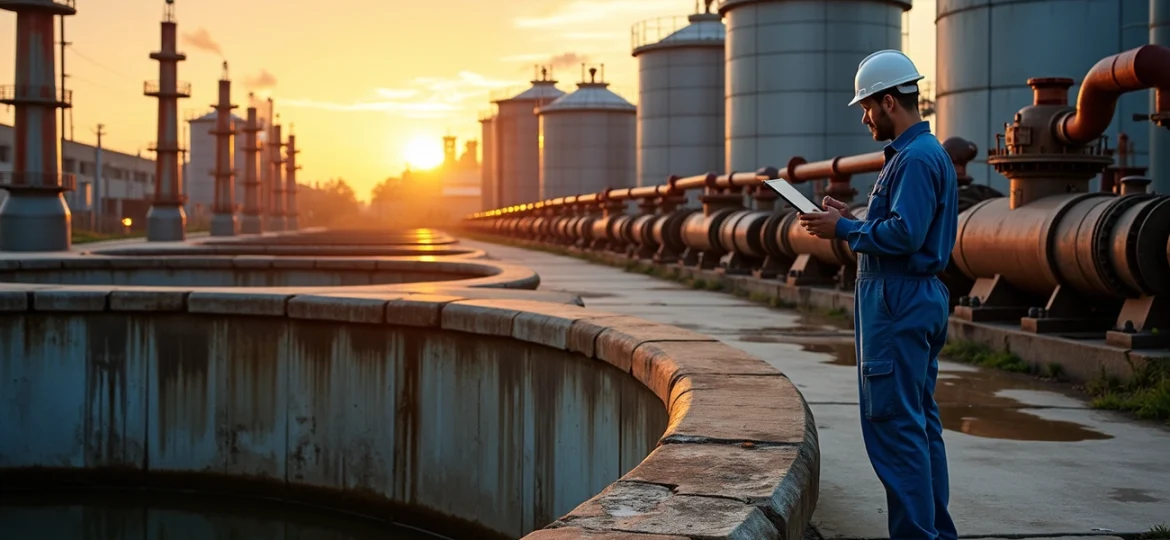A properly executed commissioning process can extend Sewage Treatment Plants (STPs) lifespan beyond 25 years. Poor commissioning substantially reduces how well these plants work. The meticulous engineering process serves as the foundation of reliable STP operation. The process typically takes five to six months based on plant complexity.
STP commissioning helps achieve project goals through a systematic process. The process ensures all components work according to design specifications. The commissioning follows a well-laid-out approach like other engineering projects. Each plant needs its own unique plan that matches specific requirements.
This piece walks you through the step-by-step process of commissioning STPs. We focus especially when you have Fecal Sludge Treatment Plants (FSTPs). These plants continue to receive worldwide recognition as economical and green sanitation solutions. These treatment facilities serve a vital role. They protect public health and the environment when built and commissioned the right way. You’ll learn about everything from pre-commissioning preparations to final handover. This knowledge helps you implement a successful commissioning process that creates productive and long-lasting treatment facilities.
Understanding STP Commissioning Scope and Objectives

STP commissioning bridges the gap between installation and operation. This critical phase will give wastewater treatment facilities their optimal performance levels. The proper commissioning builds the foundation for a treatment plant’s entire operational lifecycle, going beyond just completing a checklist.
Commissioning meaning in the context of STPs
STP commissioning verifies that all components and systems work according to specifications before full operation begins. The process tests and checks every part of the treatment plant. This includes individual components like pumps, blowers, and aeration units, as well as integrated systems.
Quality assurance lies at the heart of commissioning. It spots and fixes potential inefficiencies, mechanical problems, and installation flaws before the plant starts running. Each piece of equipment needs testing for at least 72 hours of continuous running under designed load conditions. The process applies to new installations and upgraded facilities. Plants returning to service after major maintenance or significant downtime also need commissioning.
Key goals: safety, compliance, and performance
STP commissioning works to achieve several connected goals:
Safety assurance: The plant needs proper warning signs, operational safety features for technicians (including access ladders, railings, and well-lit pathways), and clear labels for non-potable water.
Regulatory compliance: The plant must meet CPCB (Central Pollution Control Board) standards for treated effluent quality. These include parameters like BOD (≤10 mg/L), COD (≤50 mg/L), and suspended solids (≤10 mg/L).
Operational efficiency: The process parameters need optimization to remove pollutants better while keeping operational costs low.
Environmental protection: The treated effluent must meet standards before discharge to minimize effects on ecosystems.
The commissioning process checks if the plant works correctly under various conditions. It makes sure operators understand maintenance requirements. Detailed documentation and handover procedures help smooth transition to operational status.
Types of STPs: gravity-based vs. mechanical
Each STP type needs specific verification procedures during commissioning:
Gravity-based systems work without electrical components. These systems use gravitational flow for treatment. A primary settlement chamber lets solids sink to the bottom. Then, a treatment chamber with media material hosts beneficial bacteria. These plants cost less to run since they don’t need power. The commissioning faces challenges due to their low outlet invert level. This often requires pumped outlets or deep soakaways.
Mechanical STPs use various powered components for treatment. These include activated sludge process systems with biozone chambers and air diffusers. Some use rotating disk systems with biodiscs, while others employ sequencing batch reactor (SBR) systems that produce high-quality effluent. These systems need thorough electrical and mechanical testing during commissioning. Control systems need calibration and aeration cycles need optimization.
Fixed bed reactor systems combine both approaches. They use media material alongside aeration in a three-chamber design. The commissioning must verify proper flow between chambers and check if the sludge return mechanism works correctly.
Each system type needs its own commissioning protocols. This ensures all components work properly before the operations teams take over.
Pre-Commissioning Setup and Safety Protocols
Safety protocols and site validation are the life-blood of successful STP commissioning. The site needs a full inspection and verification before any commissioning work begins. The team needs careful planning and systematic execution to reduce risks in wastewater treatment operations.
Site readiness and equipment verification
A full site assessment kicks off the pre-commissioning phase. The review looks at topography, accessibility, proximity to water bodies, and compliance with local environmental regulations. The team must confirm that the location supports proper system installation and operation.
Equipment verification serves as another vital checkpoint. The team must inspect all mechanical and electrical components—pumps, blowers, valves, and control systems. They should fix any defects right away. This verification process has these steps:
- Check each component’s condition and functionality against specifications
- Confirm proper installation of screen chambers, stabilization reactors, and filtration systems
- Verify that all inspection manholes have secure covers when not in use
The commissioning team needs access to current as-built drawings. Outdated documentation might miss vital electrical connections or mechanical elements that need isolation during maintenance. So, the team must review proper documentation as a mandatory pre-commissioning activity.
Safety gear and PPE requirements
Personal Protective Equipment (PPE) keeps workers safe during STP commissioning. Sewage contains harmful contaminants, so workers must wear appropriate protective gear at all times:
- Splash-proof face shields or masks
- Rubber gloves and liquid-repellent coveralls or aprons
- Anti-slip boots and hard hats
- Long-sleeved shirts and long trousers
The treatment plant must always have first aid kits, lime or chlorine solution, hand sanitizer, and spare gloves ready. On top of that, operators should follow strict personal hygiene practices. They must wash and disinfect hands after tasks, avoid eating or drinking during operations, and keep protective gear clean through daily disinfection.
Lockout-Tagout (LOTO) and hazard identification
LOTO procedures are vital to STP safety systems. The systematic process controls hazardous energy during equipment maintenance or repair. The process follows these steps:
Authorized personnel identify all hazardous energy sources that need control. They create specific procedures for equipment lockout or tagout. Workers receive training on these procedures and machinery hazards. The team implements procedures and monitors compliance regularly.
The team needs equipment manuals to identify all power sources and determine disconnection methods for proper LOTO implementation. They must secure switches that control energization and limit key access to authorized personnel only.
Hazard identification goes beyond electrical risks to include:
- Confined spaces (tanks, pits, chambers) with limited entry/exit points and poor ventilation
- Chemical exposure risks from treatment substances
- Biological hazards from pathogens in sewage
- Fall hazards from elevated work areas
- Mechanical entanglement risks from moving parts
The commissioning process needs clear hazard marking with color-coded systems. Yellow barriers mean “do not cross without permission” while red barriers mean “do not cross unless signed onto the tailboard.” The team must set up complete emergency protocols. These include backup power sources, hazardous material inventories, staff training on emergency procedures, and identification of flood-prone areas.
Step-by-Step Commissioning of STP Modules

A successful STP commissioning just needs careful attention to detail and technical expertise. Each component must pass specific validation procedures to work optimally within the treatment system.
Screen Chamber: Bar screen installation and testing
The screen chamber starts the commissioning process by blocking large debris from entering other treatment units. Bar screens must be secured with 15-40mm spacing between bars. The commissioning engineer should check:
- Correct installation angle (60°-80° from horizontal for manual screens)
- Proper bar spacing and secure mounting
- Mechanical cleaning mechanisms work properly if installed
Water tests through screens should maintain flow velocity between 0.6-0.7 m/s at peak throughput. This velocity helps capture debris without excessive head loss. The screen chamber should be cleaned after each fecal sludge discharge.
Stabilization Reactor: Sludge level and scum removal
Stabilization reactor commissioning focuses on sludge management capabilities. These multi-chamber units (typically 3-4 chambers with 2-2.5m sludge depth) should validate:
- Sludge retention time of 7-10 days
- Submersible pumps and valve arrangements work correctly
- Scum prevention or removal mechanisms function well
Scum formation deserves special attention as it contains greasy materials and gas bubbles. Circulation systems must pump liquor from beneath scum onto its surface to break up stiff scum layers, which can grow up to 26 inches thick without management.
Sludge Drying Beds: Filter media and drainage checks
Sludge drying beds need proper validation of filter media composition and drainage. Commissioners should verify:
- Correct layering: 30cm sand (0.5-0.75mm grain size), 15-25cm transition layer (fine/medium gravel), and 25-40cm coarse gravel
- Underdrainage system with 1-3% bottom slope
- Sand filtration properties meet standards (uniformity coefficient not greater than 4)
Proper filter media arrangement allows complete drying in 10-15 days. The 350mm filter configuration shows optimal contaminant removal efficiency.
Integrated Settler and Anaerobic Filter: Flow and vent pipe validation
These modules must validate:
- Tank’s watertight integrity
- Anaerobic filter media installation
- Vent pipe installation for gas release
- Upflow system works with 12-36 hours hydraulic retention time
Filter media should provide 90-300m² surface area per m³ of reactor volume. Flow tests confirm upward movement through filter media without clogging or short-circuiting.
Horizontal Planted Gravel Filter: Media and plant health check
Horizontal planted gravel filter commissioning involves:
- Graded gravel media installation check
- Proper planting of emergent macrophytes (Phragmites australis)
- Even flow distribution validation
Plant establishment should reach approximately nine plants/m².
Polishing Pond and Final Collection Tank: Overflow and algae control
Final commissioning steps should verify:
- Overflow mechanisms between polishing pond and collection tank
- Algae control measures
- Chlorination system functionality if installed
These units should maintain about one day’s retention time. Regular maintenance schedules help prevent excessive algae growth.
Data Logging, Testing, and Quality Verification
The right way to prove STP performance works requires careful data logging and quality checks. The commissioning process needs systematic testing and documentation to set baseline operations and meet environmental standards.
Sludge and effluent water analysis protocols
The treatment effectiveness depends on proper analytical procedures. Laboratory teams must analyze dried sludge samples chemically and biologically to verify proper FSTP operation and make sure the product is safe before discharge or reuse. The effluent water needs regular sampling with lab analysis of key parameters like BOD, COD, TSS, and pH.
Quality analysis tracks these parameters:
- pH, DO (Dissolved Oxygen), and MLSS (Mixed Liquor Suspended Solids) measurements
- Inlet and outlet flow readings
- Treated water compliance with MPCB standards
The sampling methods make a substantial difference. Teams should collect surface water samples from well-mixed river sections about 30cm below the surface using weighted bottles or DO samplers. The groundwater monitoring samples must come from active wells that people use for domestic or irrigation supply, not from abandoned wells.
Sludge discharge logbook and drying time tracking
Proper operational records are the life-blood of successful commissioning. A daily logbook that records sludge discharge details—including load volume, truck identification, and discharge timing—helps learn about feed rates and operational patterns. These records verify that the system receives only domestic sludge, which protects biological treatment processes from industrial contaminants.
The monitoring of drying time in Sludge Drying Beds (SDBs) plays a crucial role among other tracking needs. SDBs need 10-12 days of rest between loadings. Recording actual drying times in different weather conditions helps streamline processes and treatment cycles.
Checklist-based validation for each module
Each STP module needs verification against standard criteria after installation. Equipment calibration, especially for pH meters and DO meters, will give accurate data collection. The complete validation has sections on major equipment overhaul scheduling and filter media replacement checks.
The MPCB/PCB compliance reporting relies on periodic maintenance documentation. Digital parameter logs and maintenance activity records provide a full picture during final commissioning stages.
Final Handover and Operational Readiness
The STP commissioning process will conclude with a vital handover phase after testing and confirming all modules. This final stage will give a solid foundation for running and managing the treatment facility in an eco-friendly way.
Pre-commissioning report and documentation
A detailed documentation package is the foundation of a proper handover. The pre-commissioning report needs site assessments, mechanical completion certificates, and component verification results. The team should submit and get approval for as-built drawings that show installation changes. Documentation packages should include manufacturer’s data sheets, test certificates, and operation and maintenance manuals. These materials help teams troubleshoot and maintain the facility in the future.
Training for operators and ULB engineers
The focus turns to building capabilities once documentation is complete. Plant operators and Urban Local Body (ULB) engineers need training in:
- Daily operational procedures
- Routine maintenance schedules
- Troubleshooting common issues
- Safety protocols and emergency responses
A well-laid-out training calendar helps ULBs host sessions that let workers participate effectively. ULB engineers who take over FSTPs need an all-encompassing understanding of plant operation and maintenance requirements.
Handover checklist and performance trial run
The plant needs to run continuously for 72 hours as the final validation step. This uninterrupted operation shows that all systems work as designed under normal conditions. Performance guarantee testing confirms that input and output parameters meet quality and quantity specifications. All stakeholders must sign a formal handover certificate after the plant shows it meets design parameters.
Conclusion
Proper commissioning is the life-blood of successful STP implementation. It determines if a facility will reach its designed 25-year lifespan or not. This piece breaks down the detailed process that turns a newly built plant into a working wastewater treatment system.
Safety must come first in all commissioning activities. The right PPE, hazard identification, and LOTO protocols keep workers safe. These practices also set up safe operations for the plant’s service life. Each module needs systematic checks – from screen chambers to polishing ponds. This verifies that all parts work well on their own and together.
Data collection and analysis form the scientific foundation of commissioning. Testing confirms that effluent quality meets regulatory standards and sets baseline operational parameters. This information becomes a great way to get insights for future troubleshooting and improvements.
The final handover is more than just paperwork. Good documentation, detailed operator training, and a successful 72-hour trial run are the foundations for sustainable operation. These elements equip local authorities and plant operators to keep treatment working well after the commissioning team leaves.
STP commissioning needs careful attention to detail and technical expertise. But this investment brings big returns through better public health, environmental protection, and operational efficiency. A well-commissioned plant meets current regulatory requirements and stays resilient against changing conditions and growing needs. It truly serves as essential infrastructure for communities worldwide.
Key Takeaways
Proper STP commissioning is critical for achieving optimal plant performance and can extend facility lifespan to over 25 years when executed correctly.
• Follow systematic module validation: Commission each component sequentially—screen chambers, stabilization reactors, sludge drying beds, and filters—with specific testing protocols for optimal integration.
• Prioritize safety protocols throughout: Implement proper PPE, LOTO procedures, and hazard identification to protect personnel and establish safe operational practices for the plant’s entire service life.
• Maintain rigorous data logging and testing: Document sludge discharge patterns, track drying times, and conduct comprehensive water quality analysis to ensure regulatory compliance and establish baseline parameters.
• Execute thorough handover procedures: Complete 72-hour continuous operation testing, provide comprehensive operator training, and deliver complete documentation packages to ensure sustainable long-term operation.
• Understand system-specific requirements: Tailor commissioning approaches based on STP type—gravity-based systems require different validation procedures than mechanical systems with powered components.
When properly executed, STP commissioning transforms newly constructed facilities into reliable wastewater treatment systems that protect public health and environmental resources while meeting stringent regulatory standards for decades of operation.
Frequently Asked Questions
Q1. What are the key stages in commissioning an STP?
The main stages include pre-commissioning setup, module-by-module validation, data logging and testing, and final handover. Each stage involves specific tasks like equipment verification, safety protocols implementation, performance testing, and operator training.
Q2. How long does the STP commissioning process typically take?
The commissioning process for a Sewage Treatment Plant typically requires five to six months, depending on the complexity of the plant. This timeframe allows for thorough testing and validation of all components and systems.
Q3. What safety measures are essential during STP commissioning?
Critical safety measures include proper use of Personal Protective Equipment (PPE), implementation of Lockout-Tagout (LOTO) procedures, hazard identification, and establishment of emergency protocols. Regular safety training for all personnel is also crucial.
Q4. How is the quality of treated water verified during commissioning?
Water quality is verified through rigorous testing and analysis. This includes regular sampling of effluent water and laboratory analysis of key parameters such as BOD, COD, TSS, and pH to ensure compliance with environmental standards.
Q5. What documentation is required for the final handover of an STP?
The final handover requires comprehensive documentation including a pre-commissioning report, as-built drawings, manufacturer’s data sheets, test certificates, and operation and maintenance manuals. A formal handover certificate signed by all stakeholders is also necessary.






